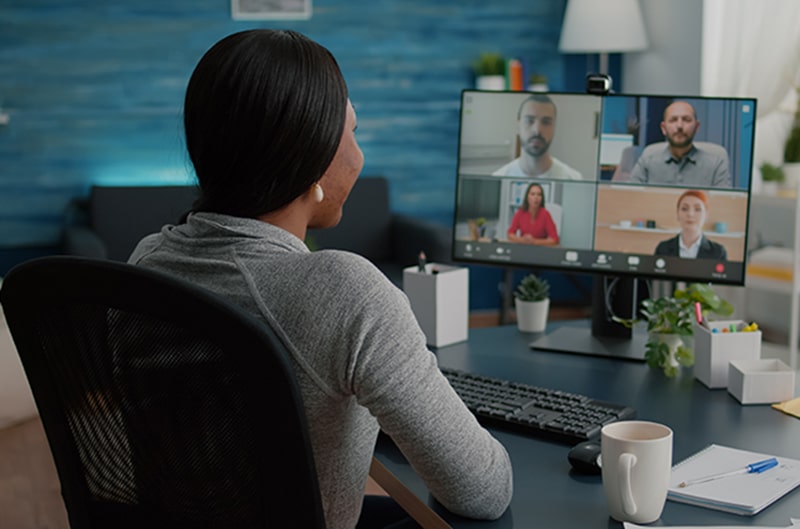The popularity of video conference surged during the pandemic, allowing companies to collaborate effectively with teams and clients regardless of their geographical location. Meeting transcription services ensure that the content is recorded for official purposes and that all participants have equal access to it. With the convenience it offers along with its time and cost saving abilities, video conferencing is here to stay, more so with hybrid work models. According to Fortune Business Insights, the value of the global video conferencing was $5.32 billion in 2019, and will grow to $10.92 billion by 2027. Gartner predicts that only 25% of business meetings will take place in-person by 2024. However, even as remote conferencing allow employees to stay connected, the security of online meetings is a major concern for organizations. “Zoom-bombing” has made organizations wonder if online meeting platforms are safe for sharing confidential information in these sessions.
What is Zoom-bombing?
Zoom-bombing is when a teleconferencing session/meeting is hijacked by strangers. While the term was coined to describe safety incidents on Zoom, it applies to all video conferencing platforms. Hackers intrude on virtual work meetings to steal privileged client and attendee information and other proprietary information, and even disrupt the sessions with improper graphics and conversation. Zoom bombing can have particularly damaging impacts for board meetings, financial services, law enforcement organizations.
Most video conferencing platforms have improved their security features to prevent hackers from bypassing them. Nevertheless, focus on cybersecurity is essential to prevent hackers from raiding your virtual conferences. There are various steps you can take to mitigate risk of privacy intrusions.
How to Keep Online Meetings Safe
- Choose secure video conferencing software: Quality browser based platforms come with features like digital whiteboards, multimedia sharing, polls, question upvotes event replays, integrations, breakout rooms and data analytics. Secure video conference features to look for include: authentication protocols such as multi-factor authentication (MFA) and single sign-on (SSO); screen sharing; safe file exchange; data erasure so that your personal data can be deleted at any time; data backups; end-to-end data encryption and IDS/IPS to identify malware and protect data. Zoom, Microsoft Teams, GoToMeeting, Google Meet, and Cisco Webex are reliable, feature-rich video conferencing platforms. Do your research well to choose the best option for your team. Have an expert assess the platform to confirm it has robust security capabilities before you invest in it.
- Set a meeting ID and password: Setting a meeting ID and strong passcode can make your meetings more secure and keep hackers and strangers out. Every attendee must enter the passcode before they can join the meeting. Account owners and admins can also lock passcode. Password protections are on by default on Zoom and users should keep those protections on to prevent unintended participants from joining the meeting.
- Invite your participants directly: This will give you more control over who know about the online meeting. Don’t make private meetings public by sharing the link on social media or any other public forum as anyone who gets access to your personal password can enter the room. Always send a personal email invite to each participant along with the secure auto-generated invite. This will helps people know your invite is legitimate. Tell attendees to reach out to you if they receive a meeting invitation that you sent. These authentications will prevent unwanted attendees from getting access to your video conference. Make sure your guests understand cybersecurity by sending them a notification about best practices for online safety.
- Keep an eye out for uninvited guests: Pay attention to the list of meeting participants in the management panel. When a new person joins, make sure they fit into the list. Keep a look out for people who appear in the attendee list but don’t have a camera image, says www.appliedi.net. Another thing to watch out for is duplication – hackers use a mirror, a snapshot, or a video clip of a real meeting member. If you notice anything untoward, disallow the extra account and secure you meeting. Also watch out for strange sounding audio and unexpected and/or disruptive media as these could be signs that your meeting is being hacked.
- Validate potential guests: Pre-screening potential guests before they enter the conference is the best way of making sure every guest is authentic. Setting up a waiting room or green room will allow you to check on the attendees of a virtual meeting. Validating attendees will prevent uninvited people from joining the event. You can also designate a person to actively monitor your audience during the event to prevent unknown people from joining the event and keep your guests and organization secure at all times.
- Use secure file sharing and chat capabilities: If your virtual meeting software is not secure, hackers can gain access to documents, presentations, and text chat box used during the discussion. Use a secure platform and ensure that you and your team know how to use file sharing to view, edit, organize, and collaborate securely with important files remotely. Make sure that participants click only on links is shared by a known participant. If your platform is unsecured, use a secure business document management platform or secured chat channel simultaneously with the call to share important information.
- Secure home computers and networks: If you have employees working from home, make sure their computers and networks are secure. According to www.cisa.gov, “home network security refers to the protection of a network that connects devices- such as routers, computers, smartphones, and Wi-Fi-enabled baby monitors and cameras- to each other and to the internet within a home”. Make sure your team knows about the steps to take to reduce attack risks in their home network and make it more difficult to hack. This would include settings configuration, a proper firewall, virus scanning and cleaning software, and network monitoring tools to spot red flags.
- Close the meeting: Secure meetings should be closed when they end. Attendees should log off to prevent hackers from gaining access during unmonitored time.
Remote work is here to stay, and so is video conferencing. While they may have started with minimum software for team collaboration, reports indicate the companies are combining virtual meetings with a full tech stack to boost security.
Recorded video conversations and their transcripts are useful for team members who could not attend the meeting, and also well to assess and gather data, generate reports and gain business insights for future reference. If you are considering outsourcing your meeting transcription, vet digital transcription agencies carefully and choose a company that will provide accurate, timely and secure documentation solutions.




